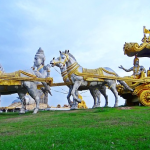Day before yesterday was the International Day of Yoga, and I would like to say: Yoga is hot. From Tihar to Bollywood, from Ivanka Trump to Michelle Obama, everyone is waxing eloquent about its benefits. Yoga’s efficacy as a spiritual, psychological and physical discipline isn’t a new discovery. It has been around for at least 5000 years, since Mohenjo-Daro and Harappa were at their zenith, passed through the hands of Patanjali of Yoga Sutras fame, and hatha yoga luminaries such as Goraknath’s Kanphata yogis, .
More recently, yoga has been making waves in the last century, especially in the West. When Swami Vivekananda spoke at the Parliament of World Religions in 1893, he opened the doors for many yogis to follow. Over the years, Paramahamsa Yogananda, Ramana Maharishi, Maharishi Mahesh Yogi and BKS Iyengar made their mark on Western minds.
Fast-forward to today: the yoga “industry” is worth 80 billion US dollars, according to the Guardian. It includes classes, apparel, accessories and a host of other products. If any further proof of yoga’s popularity is needed, you can find it in the fact that Narendra Modi’s proposal at the United Nations to celebrate International Yoga Day, was the most popular resolution in the history of the UN. It was supported by 177 nations.
Yoga is now a global phenomenon, and it is heartening to see the Indian government realizes the potential for yoga as a soft-power. Every year, on June 21, International Yoga Day, the Indian government has been reaching out through its embassies to spread yoga among people in other nations.
However, the world’s interest in what is yoga is going through a transition. India’s yogis are no longer just seen as yoga teachers or spiritual leaders. They are morphing into much more. Take for example, the recent launch of the UN’s Water Action Decade. Who do you find on the panel of experts? Sadhguru, the founder of Isha Foundation. Sadhguru’s presence there is not as a spiritual leader, but as an environmentalist. His talk is not about spiritual precepts but about action items for nations facing a water crisis.
Sadhguru is also drawing interest from the medical community in the United States. In May, he was at Harvard Medical School, in conversation with two neuroscientists, discussing how the science of anaesthesia could be refined and perfected.
On a similar vein, Baba Ramdev’s Patanjali was a case study in the prestigious Harvard Business Review and at Wharton, as his FMCG disrupts multinationals such as Unilever. The case study was not interested in his popular yoga classes. They were focused on his strategy of converting his brand and image into market share for Patanjali, making it a leader in FMCG in an incredibly short span of time.
This transformation of India’s yogis, from being just spiritual guides to becoming beacons of “worldly” knowledge and wisdom, must be tapped by the nation and the government. This will not only make it easier for other Indians to shine internationally, it will also open up global markets for many of India’s unique products.
For example, Ayurveda and Siddha can be a game-changer in the medical industry. Today, the world’s most troublesome ailments are chronic ailments, accounting for 71% of all deaths globally. Western medicine has no real answer for these illnesses. Doctors only help patients manage these ailments, without actually curing them. Ayurveda, Siddha and Yoga can be very beneficial for such patients. Yoga is being studied today as a potential cure for everything from asthma to cardiovascular problems.
Health is only the tip of the iceberg. India’s traditional textiles, which were once the envy of the world, could find new life, as yoga recommends using organic clothing. India’s handloom sector, and all its phenomenal diversity, is in steep decline today. Reviving the handloom sector will have a booster effect on India’s employment statistics, as handloom employs a large number of people.
India’s farmers would benefit too. Yoga recommends eating organically-grown produce. Take Art of Living’s “organic food” business as an example. The sheer number of farmers in India, coupled with the variations in its land and climate, allows a vast array of crops to be grown here. India has the potential to become a leader in organic food production and a hub for associated products, if only the global market picks up.
There are many other avenues waiting to open as the world takes a greater interest in the capabilities of our yogis. India’s classical art forms, music and dance, tourism etc. are just a few that come to mind. But all this becomes possible only if the government takes a strategic and calibrated approach to showcase these individuals.
Crucially, as the West – namely the United States and Europe – wanes, and the East – China and India – rises, using our yogis as soft-power gives India an edge over China. China has economic and military heft. But it is failing to leave a footprint in the world beyond these two realms. No one wants to copy the Chinese. Even the heydays of Kung Fu movies passed when Hong Kong was returned to China, and Hollywood has thoroughly Americanized this martial art – Kung Fu Panda bears witness to that.
In contrast, Hollywood, Coke, McDonald’s and blue jeans have almost universal appeal, serving not only as conduits for American commerce, but also as soft-power icons. Wealth and military might are important, but not sufficient for a nation to shape the rest of the world in its image.
Of course, it is no one’s case that just soft-power will help India take centre-stage in the world. Economic and military might needs to be harnessed too. But soft-power supports economic growth, and can also be a diplomatic ace, reducing the need for military interventions.
China has no popular soft-power “weapon” as of now. Before they develop something, and before the United States thoroughly Americanizes yoga too, India needs to capitalize on its head-start. Yoga and yogis can be the catalyst India needs to become a true superpower.















